Published online by Cambridge University Press: 27 October 2009

page 77 note 1 Λαοαρ鎱φία V (1915), 450.
page 77 note 2 Jacoby, correcting the papyrus in l.1, replaces αὐτοῖσ by the masculine αὐτῷ, which can hardly be accepted when one has in mind the whole sentence: οὐ γ⋯ρ ἦν αὐτ⋯ι ⋯ς ἔρον παῖδας τεκέν.
page 77 note 3 Απομνημονε⋯ματα στρατηγο⋯ Ιω. Μακρυγιάννη, 85.
page 77 note 4 I am indebted to Havers, W., Handbuch der erkldäenden Syntax (1931). 168, for this term.Google Scholar
page 77 note 5 e.g. in Z 158 ff.
page 78 note 1 Pind. fr. 167, Apoll. Rhod. i. 63 f.; compare Ovid, ,Metatn. 12. 507 f.;Google ScholarApollod, . Epit. 1. 22,Google Scholar Schol. A on Il. A 264. The scene of the Lapith king already half buried in the groundis also represented in vases, e.g. on the black-figured crater of Ergotimus and Clitius, as well as on temple-friezes, that of the temple of Athena at Sunium, that of the temple of Apollo at Phigalea, that of the so-called Theseum at Athens, etc. See Robert, C., Griech. Heldensagen 1. 10, n. 6.Google Scholar
page 78 note 2 Berthold, O., ‘Die Unverwundbarkeit in Sage und Aberglauben der Griechen’, R.G.V.V. 2. 1, p. 17 f.Google Scholar
page 78 note 3 See Lesky, A., ‘Alkestis, der Mythus und das Drama’, Sitzb. Wien. Ak. 1925, 3f.Google Scholar
page 78 note 4 See my paper Τιθωνός, Wien. Studien, 68, 1930, 25 f.Google Scholar
page 79 note 1 Hypoth. of Sophocles' Ajax; Sophron, fr. 32.
page 79 note 2 Schol. on Soph. Ajax, 833.
page 79 note 3 Stat. Achill. i. 269 f.;Google ScholarServ. Aen. vi. 57.Google ScholarSee Robert, C., Griech. Heldensagen, p. 1187, n. 4.Google Scholar
page 80 note 1 The first published by Politis, N., Παραδόσεις i. 52, n. 89; the second recorded by M. Andronikos.Google Scholar